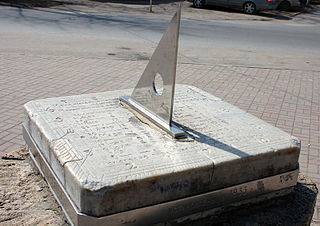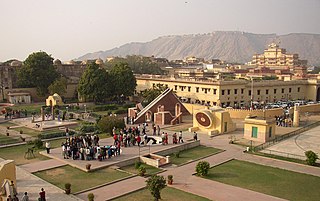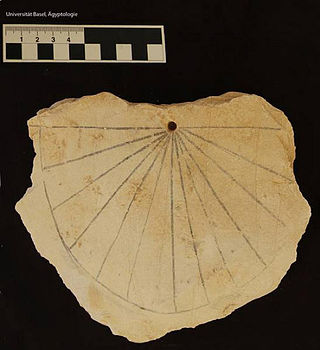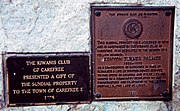
A sundial is a horological device that tells the time of day when direct sunlight shines by the apparent position of the Sun in the sky. In the narrowest sense of the word, it consists of a flat plate and a gnomon, which casts a shadow onto the dial. As the Sun appears to move through the sky, the shadow aligns with different hour-lines, which are marked on the dial to indicate the time of day. The style is the time-telling edge of the gnomon, though a single point or nodus may be used. The gnomon casts a broad shadow; the shadow of the style shows the time. The gnomon may be a rod, wire, or elaborately decorated metal casting. The style must be parallel to the axis of the Earth's rotation for the sundial to be accurate throughout the year. The style's angle from horizontal is equal to the sundial's geographical latitude.

A gnomon is the part of a sundial that casts a shadow. The term is used for a variety of purposes in mathematics and other fields.

Carefree is a town in Maricopa County, Arizona, United States. It is a suburb of both Phoenix and Scottsdale, located in the far northeast area of the Phoenix Metropolitan Area. As of the 2020 United States census, the population of the town was 3,690.

The Sundial Bridge is a cantilever spar cable-stayed bridge for bicycles and pedestrians that spans the Sacramento River in Redding, California, United States and forms a large sundial. It was designed by Santiago Calatrava and completed in 2004 at a cost of US$23.5 million. The bridge has become iconic for Redding.

The Jantar Mantar, Jaipur is a collection of 19 astronomical instruments built by the Rajput king Sawai Jai Singh, the founder of Jaipur, Rajasthan. The monument was completed in 1734. It features the world's largest stone sundial, and is a UNESCO World Heritage Site. It is near City Palace and Hawa Mahal. The instruments allow the observation of astronomical positions with the naked eye. The observatory is an example of the Ptolemaic positional astronomy which was shared by many civilizations.

Analemmatic sundials are a type of horizontal sundial that has a vertical gnomon and hour markers positioned in an elliptical pattern. The gnomon is not fixed and must change position daily to accurately indicate time of day. Hence there are no hour lines on the dial and the time of day is read only on the ellipse. As with most sundials, analemmatic sundials mark solar time rather than clock time.

Man Enters the Cosmos is a cast bronze sculpture by Henry Moore located on the Lake Michigan lakefront outside the Adler Planetarium in the Museum Campus area of downtown Chicago, Illinois.

The Solarium Augusti or Horologium Augusti was a monument in the Campus Martius of ancient Rome constructed in 10 BCE under the Roman emperor Augustus. It included an Egyptian obelisk that had first been erected under the pharaoh Psamtik II used in some fashion as a gnomon. Once believed to have been a massive sundial, it is now more commonly understood to have been used with a meridian line used to track the solar year. It served as a monument of Augustus having brought Egypt under Roman rule and was also connected with the Altar of Augustan Peace commemorating the Pax Romana established by his ending the numerous civil wars that ended the Roman Republic. The Solarium was destroyed at some point during the Middle Ages. Its recovered obelisk is now known as the Obelisk of Montecitorio.

Located in Frankfort, Kentucky, overlooking the state capital, Kentucky Vietnam Veterans Memorial contains the names of 1,108 Kentuckians killed in the Vietnam War. The memorial is in the form of a sundial with the names placed so that the tip of the gnomon's shadow touches each man's name on the date of his death, thus giving each fallen warrior his own personal memorial day.

John Ingle Yellott was an American engineer recognized as a pioneer in passive solar energy, and an inventor with many patents to his credit. In his honor the American Society of Mechanical Engineers (ASME) Solar Division confers a biannual "John I. Yellott Award" which "recognizes ASME members who have demonstrated sustained leadership within the Solar Energy Division, have a reputation for performing high-quality solar energy research and have made significant contributions to solar engineering through education, state or federal government service or in the private sector."

Astronomical rings, also known as Gemma's rings, are an early astronomical instrument. The instrument consists of three rings, representing the celestial equator, declination, and the meridian.

The Gnomon of Saint-Sulpice is an astronomical measurement device located in the Church of Saint-Sulpice in Paris, France. It is a gnomon, a device designed to cast a shadow on the ground in order to determine the position of the sun in the sky. In early modern times, other gnomons were also built in several Italian and French churches in order to better calculate astronomical events. Those churches are Santa Maria del Fiore in Florence, San Petronio in Bologna, and the Church of the Certosa in Rome. These gnomons ultimately fell into disuse with the advent of powerful telescopes.

A sundial is a device that indicates time by using a light spot or shadow cast by the position of the Sun on a reference scale. As the Earth turns on its polar axis, the sun appears to cross the sky from east to west, rising at sun-rise from beneath the horizon to a zenith at mid-day and falling again behind the horizon at sunset. Both the azimuth (direction) and the altitude (height) can be used to create time measuring devices. Sundials have been invented independently in every major culture and became more accurate and sophisticated as the culture developed.

The Whitehurst & Son sundial was produced in Derby in 1812 by the nephew of John Whitehurst. It is a fine example of a precision sundial telling local apparent time with a scale to convert this to local mean time, and is accurate to the nearest minute. The sundial is now housed in the Derby Museum and Art Gallery.

A London dial in the broadest sense can mean any sundial that is set for 51°30′ N, but more specifically refers to a engraved brass horizontal sundial with a distinctive design. London dials were originally engraved by scientific instrument makers. The trade was heavily protected by the system of craft guilds.

A tide dial, also known as a Mass or scratch dial, is a sundial marked with the canonical hours rather than or in addition to the standard hours of daylight. Such sundials were particularly common between the 7th and 14th centuries in Europe, at which point they began to be replaced by mechanical clocks. There are more than 3,000 surviving tide dials in England and at least 1,500 in France.
A schema for horizontal dials is a set of instructions used to construct horizontal sundials using compass and straightedge construction techniques, which were widely used in Europe from the late fifteenth century to the late nineteenth century. The common horizontal sundial is a geometric projection of an equatorial sundial onto a horizontal plane.

The Class of 1885 Memorial Sundial is a landmark at Columbia University, located at the center of the College Walk at the other end of Butler Plaza from Butler Library. Designed by astronomy professor Harold Jacoby in conjunction with McKim, Mead & White, it was completed in 1914. The 16-short-ton (15 t) granite sphere that once sat on top of it, at some point considered the largest stone sphere in the world, was removed in 1946 after it began to crack; efforts have been made toward its recovery since it was rediscovered in Michigan in 2001. The sundial's bare platform now serves as a popular meeting area for students, as well as a center for campus politics.























